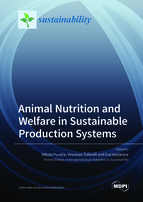Animal Nutrition and Welfare in Sustainable Production Systems
A special issue of Sustainability (ISSN 2071-1050).
Deadline for manuscript submissions: closed (30 October 2021) | Viewed by 24669
Special Issue Editors
Interests: animal science; nutrition; antimicrobials; antibiotic alternatives; veterinary; biotechnology; genetics; toxicology
Special Issues, Collections and Topics in MDPI journals
Interests: animal nutrition; poultry nutrition; feed science; feed technology
Special Issues, Collections and Topics in MDPI journals
Interests: animal protection; animal welfare; animal behavior; stress; husbandry; transport; slaughter
Special Issues, Collections and Topics in MDPI journals
Special Issue Information
Dear Colleagues,
Today, food animal production systems demand high energy, land, chemicals, and water—all of which are increasingly becoming scarce. Thus, change and innovation are required in many animal production systems to meet present and future demand for animal products sustainably. During the last four decades, inexpensive grain, energy, and protein have enabled the economic development of intensive meat, eggs, and milk production systems based on feeding grains and other ingredients sourced from far-off places. The poultry and pig intensive production systems have become highly capital intensive, and they have resulted in many environmental challenges.
If the price of feedstuffs rises above a critical level, they might even become economically and environmentally unviable. These issues may become magnified due to increasing competition for arable land for food, feed, and biofuel production. So far, in many situations, the feed has been produced, and nutrition has been balanced to achieve maximum production, with high economic benefits. However, it has also contributed to ecosystem degradation and global warming through methane and nitrous oxide. Moreover, animal production results in increased energy consumption at every step, and even more so in intensive systems. These situations demand attention to examine the excessive use of resources and consider ways to adopt more efficient processes and procedures.
Food animal feed, nutrition, and welfare are the foundation of successful animal systems. They directly or indirectly affect the entire animal production sector, associated services, public goods, and services, including animal productivity, health and welfare, product quality and safety, land use and land-use change, and greenhouse gas emissions. The sustainability of food animal nutrition and welfare is crucial in developing animal production across production systems. The sustainable increase in animal productivity, which is key to meeting the large current and future demand for animal origin products, cannot be achieved without sustainable animal nutrition and welfare.
Sustainable animal nutrition and welfare are expected to be beneficial for the food animal, the environment, and society. Additionally, they are likely to generate socioeconomic benefits, furthering poverty alleviation and food security efforts. This requires researchers, extension workers, science managers, policy-makers, industry, and farmers.
This Special Issue welcomes papers focused on the latest knowledge and innovations in sustainable animal production, animal nutrition, animal welfare, animal behavior, agricultural economy, policy and management, sustainable feedstuff technology, and food safety principles. Both review and research papers are welcome to show originality and give a significant contribution to the scope of the Special Issue.
Prof. dr Nikola Puvača
Prof. dr Vincenzo Tufarelli
Prof. dr Eva Voslarova
Guest Editors
Manuscript Submission Information
Manuscripts should be submitted online at www.mdpi.com by registering and logging in to this website. Once you are registered, click here to go to the submission form. Manuscripts can be submitted until the deadline. All submissions that pass pre-check are peer-reviewed. Accepted papers will be published continuously in the journal (as soon as accepted) and will be listed together on the special issue website. Research articles, review articles as well as short communications are invited. For planned papers, a title and short abstract (about 100 words) can be sent to the Editorial Office for announcement on this website.
Submitted manuscripts should not have been published previously, nor be under consideration for publication elsewhere (except conference proceedings papers). All manuscripts are thoroughly refereed through a single-blind peer-review process. A guide for authors and other relevant information for submission of manuscripts is available on the Instructions for Authors page. Sustainability is an international peer-reviewed open access semimonthly journal published by MDPI.
Please visit the Instructions for Authors page before submitting a manuscript. The Article Processing Charge (APC) for publication in this open access journal is 2400 CHF (Swiss Francs). Submitted papers should be well formatted and use good English. Authors may use MDPI's English editing service prior to publication or during author revisions.
Keywords
- Sustainability
- Animal production
- Animal nutrition
- Animal welfare
- Animal behavior
- Agribusiness
- Food/feed
- Sustainable rural development








